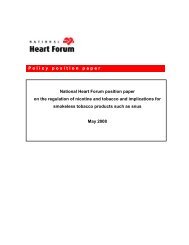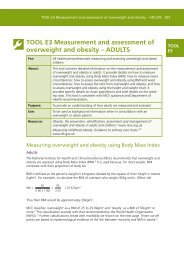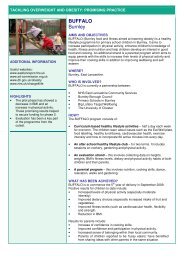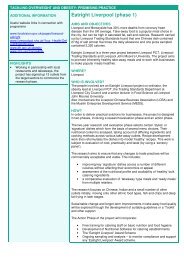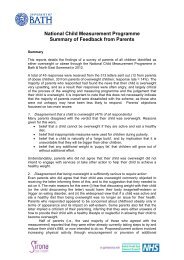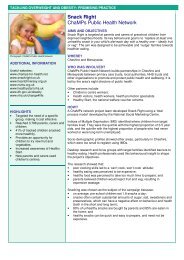Public Health Law and Non-communicable Diseases - UK Health Forum
Public Health Law and Non-communicable Diseases - UK Health Forum
Public Health Law and Non-communicable Diseases - UK Health Forum
You also want an ePaper? Increase the reach of your titles
YUMPU automatically turns print PDFs into web optimized ePapers that Google loves.
Clearly, governments have much to gain – <strong>and</strong> certain targets to meet – through the<br />
implementation of effective prevention techniques.<br />
2.2 NCD risk factors <strong>and</strong> interventions<br />
As stated above, the proximate causes of NCDs across all countries include tobacco use,<br />
harmful use of alcohol, the over-consumption of saturated fat, sugar <strong>and</strong> salt, <strong>and</strong> lack of<br />
physical activity. While many interventions may be cost-effective, WHO has classified some as<br />
‘best buys’ – meaning “actions that should be undertaken immediately to produce accelerated<br />
results in terms of lives saved, diseases prevented <strong>and</strong> heavy costs avoided.” These are listed in<br />
Table 1.<br />
Table 1: The World <strong>Health</strong> Organization’s ‘best buys’ for NCD interventions<br />
• Protecting people from tobacco smoke <strong>and</strong> banning smoking in public places<br />
• Warning about the dangers of tobacco use<br />
• Enforcing bans on tobacco advertising, promotion <strong>and</strong> sponsorship<br />
• Raising taxes on tobacco<br />
• Restricting access to retailed alcohol<br />
• Enforcing bans on alcohol advertising<br />
• Raising taxes on alcohol<br />
• Reducing salt intake <strong>and</strong> salt content of food<br />
• Replacing trans fats in food with polyunsaturated fat<br />
• Promoting public awareness about diet <strong>and</strong> physical activity, including through mass media.<br />
Source: World <strong>Health</strong> Organization, 2011 11<br />
There is substantial evidence of the success of preventive interventions. Frequently cited is the<br />
case of Finl<strong>and</strong>’s North Karelia province, where a policy focused on healthy diet, exercise <strong>and</strong><br />
reduction of smoking was implemented in the early 1970s. Between 1972 <strong>and</strong> 2006, North<br />
Karelia witnessed an 85% decrease in annual mortality rate from coronary heart disease. 12<br />
More recently, in New York City, a five-year-old <strong>Health</strong> Department regulation banning trans<br />
fats has reduced the consumption of trans fats among fast-food customers from about 3 grams<br />
to 0.5 grams per purchase – showing also that local health regulations can significantly<br />
influence public consumption. 13<br />
It should be noted that corporate interests have markets to protect, <strong>and</strong> legislation restricting<br />
advertising, marketing or use of alcohol, tobacco <strong>and</strong> unhealthy foods may face numerous legal<br />
<strong>and</strong> political obstacles. Certain interventions require a cross-border approach. These may<br />
include advertising restrictions, labelling requirements, taxation <strong>and</strong> minimum unit pricing<br />
measures. A key example is the WHO’s Framework Convention on Tobacco Control – developed<br />
7



